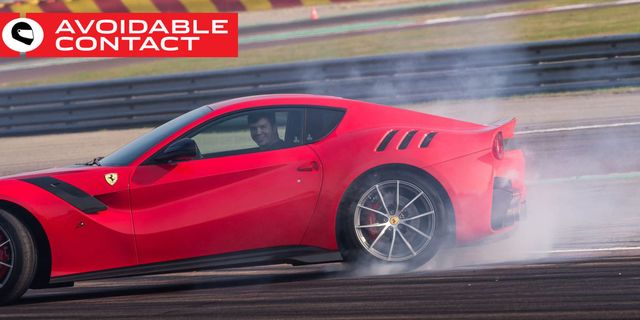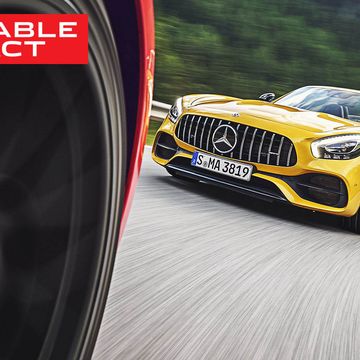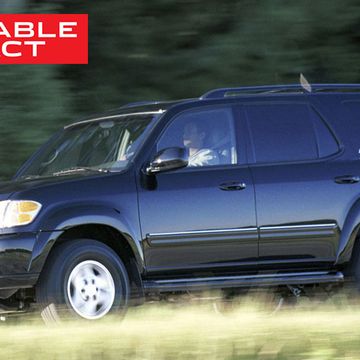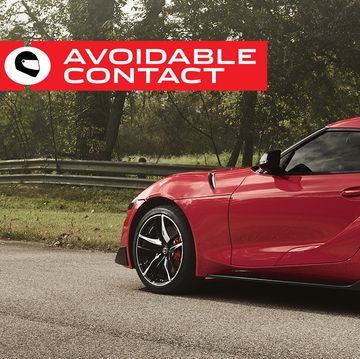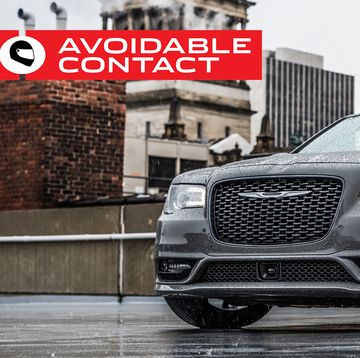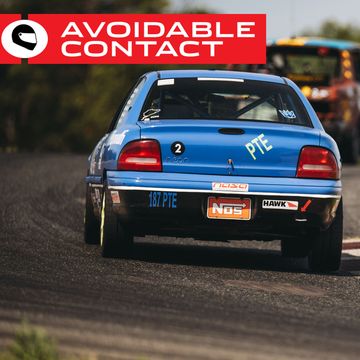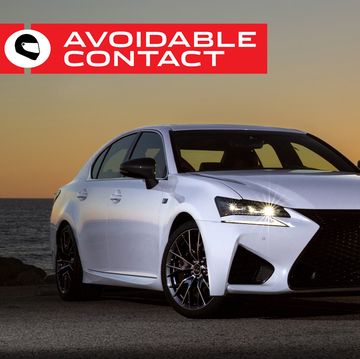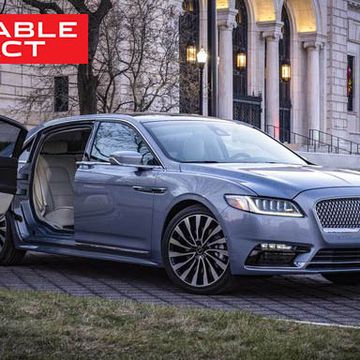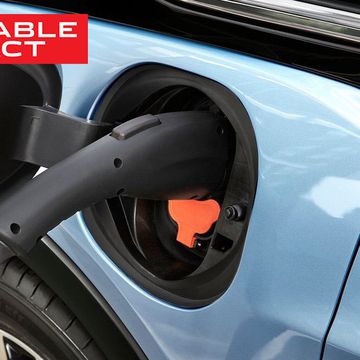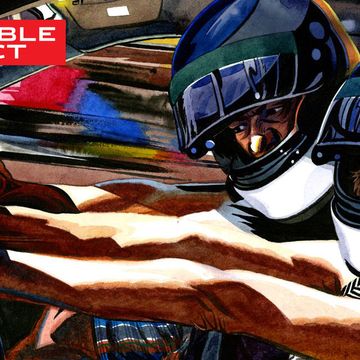The word is "Thoreauvian," and it means "of, or pertaining to, Henry David Thoreau." Regular readers of "Avoidable Contact" will recall that I've been on a bit of a Henry David kick these past few years, after twenty or so post-collegiate years where I didn't think of the man or his writing very often. It's not so much for the Thoreauvian ideas—I would no more live alone in the wild than I would get a tribal tattoo—but for the cut-glass certainty of his prose and the directed economy of his opinions. Those qualities are worth imperfectly emulating once in a while.
What I aim to do today is to provide you with a Thoreauvian explanation of how, and why, drivers find themselves in a spinning automobile. I was inspired to do this by a day I spent earlier this week driving some F2000-style open-wheel cars in the company of ten other automotive journalists. More than half of them spun in their first two sessions. I don't think any of them knew why they had looped out. They just shrugged their shoulders and accepted it.
Normally this is the sort of thing about which I would be very caustic, but as fate would have it, I spun a Lotus Evora off Turn Two at NCM Raceway Park last week and I've been replaying that mistake in my head during my flights. So let's talk about why they spun, why I spun, why you might spin, and how we can prevent most of this from happening.
The simplest—the most Thoreauvian—explanation for spinning is this: Your front wheels are moving more slowly than your back wheels. This can happen for any number of reasons. In the case of my Evora spin, it was because I did just a bit too much trail-braking going into a turn. Trail-braking is a technique that is meant to produce controlled oversteer on corner entry. You turn the car a bit while you're still touching the brakes. This slows up the front end without slowing up the back end, which then naturally tries to keep going past the front end.
You can't win a race in 2016 without trail-braking, even at the club level, but if you do it too much you're going to spin. You will also do it if you switch to a mid-engined car from a front-engined one and apply the same amount of trail-braking. Front-engined cars are naturally stable—you'd know this if you read my column on this very topic—so they have to be prodded pretty hard with trail-braking in order to spin. Mid-engined cars, on the other hand, have a lot of weight and inertia behind the driver. They are easier to turn. Easier to turn also means easier to spin. Duh. I went from a Mercedes-AMG to an Evora, did the same thing, expected the same results. Silly me.
My friends in the open-wheel cars weren't trail-braking. Not intentionally, anyway. They were all relatively inexperienced drivers who were driving cars without ESC or anti-lock brakes in what was for most of them the first time in a long time. I don't think most of us know how much we rely on ESC to save our bacon. When I was a child, the adults around me seemed to take it for granted that once in a while you'd just spin off the road in the rain or the snow or—let's face it—the drinking. These were educated people with advanced degrees and country-club memberships, but they still figured that the occasional spinning out was part and parcel of operating a motor vehicle. ESC has fixed all of that.
As far as I can tell, all of the spins I witnessed this week happened the same way:
- Driver enters a turn too fast, on the wrong line, or some combination of both;
- Driver slams on the brakes and turns at the same time;
- This completely overwhelms the front tires, which lock up and skid along uselessly for a while, producing instant and total understeer;
- Until the car slows down to the point that it's possible for those front tires to grip;
- Which they promptly do;
- And since the driver still has the steering wheel cranked, the car steers sharply without warning;
- Which slows the front end of the car further, because you can't get a lateral motion of the car without sacrificing forward motion, because there's no free lunch in physics;
- Thus producing all the conditions you need for a rapid spin.
What I want to explain to you is this: when you turn the steering wheel too much, you are SLOWING THE CAR DOWN. And if you slow it down enough, it will eventually be going slow enough that it really can give you the amount of steering for which you've asked. Add a bit of braking to the equation, and you're just speeding up the process. Eventually you're going to spin.
A car with stability control fights this situation all the way through. It starts by applying anti-lock control to the front wheels so they don't lock even if the idiot behind the wheel has the brake pedal pushed to the floor and the steering cranked 180 degrees. Then, as the car slows down and prepares to get its front-end grip back, stability control begins to brake the rear wheels to prevent the back end from overtaking the front. Finally, when the front end grips and swerves, the system will brake one of the rear wheels independently to tug the car as straight as it can.
Take the computer controls out of the equation, and most novice drivers who are trying to go quickly on a track will spin out sooner rather than later. That's what happened to my fellow journalists. After years of driving cars that coddled them when they applied too much braking and steering together on the entry to a corner, they were in no way prepared to deal with a car that was answerable only to the laws of physics.
To avoid the trail-braking spin, like the one I had last week, simply reduce your trail-braking to a safe but effective level. To avoid the other kind of spin—let's call it the Rookie Spin—try separating your inputs. Get your braking done in a straight line. Once you're going slowly enough to enter the corner, you're free to turn the wheel.
If you find yourself arriving at a corner too quickly for whatever reason, brake in a straight line until the car is slowed enough to safely turn. Yes, this will result in you having an embarrassing and slow line through the corner. You might even mow a little grass with your front bumper. But you'll stay in control of the car.
We could close here with a quote from Thoreau, but I like this one from his friend and mentor, Ralph Waldo Emerson: "A man makes inferiors his superiors by heat; self-control is the rule." Control your approach to the corner, control your steering, control your braking. If you don't, you will find yourself spun out, watching a parade of other cars go by. You can lose a race that way; I've certainly done it. I think that's what Emerson meant by "making inferiors his superiors." But he also talks about heat, which might refer to heat in the tires. Which makes me think about tire temperature management. But we've already covered that in another column. It might be that this Emerson fellow has more to say to us about how to win races. I'll have to find my old textbooks in the basement and take them out for a spin.
So to speak.
Born in Brooklyn but banished to Ohio, Jack Baruth has won races on four different kinds of bicycles and in seven different kinds of cars. Everything he writes should probably come with a trigger warning. His column, Avoidable Contact, runs twice a week.
Jack Baruth is a writer and competitor who has earned podiums in more than fifteen different classes and sanctions of automotive and cycling competition, in both amateur and professional capacities, as well as an enthusiastic hobbyist musician and audiophile who owns hundreds of musical instruments and audio systems. His work has appeared in Bicycling, Cycle World, Road & Track, WIRED, Wheels Weekly, EVO Malaysia, Esquire, and many other publications. His original design for a guitar, the Melody Burner, has been played by Billy Gibbons, Sheryl Crow, and others.
